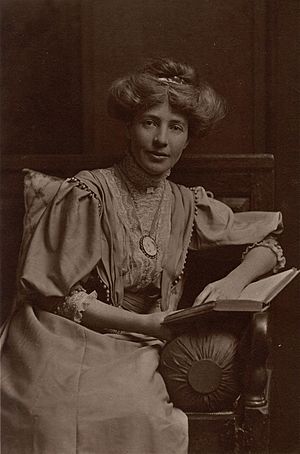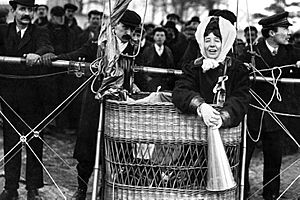Muriel Matters facts for kids
Muriel Lilah Matters (born 12 November 1877 – died 17 November 1969) was an amazing Australian woman. She was a strong supporter of women's right to vote, a speaker, writer, teacher, and actress. From 1905 until she passed away, Muriel lived in Britain. She is most famous for her work with the Women's Freedom League, fighting for women to have the right to vote in the United Kingdom.
Contents
- Early Life and Education
- Joining the Fight for Women's Rights
- Muriel's Work with the Women's Freedom League
- First Lecture Tour of Australia (1910)
- Helping Families in East London
- Campaigning in Scotland
- Marriage and Later Life
- Speaking Out Against War
- Learning the Montessori Method
- Second Lecture Tour of Australia (1922)
- Running for Parliament
- Later Life and Legacy
- Images for kids
Early Life and Education
Muriel Matters was born in Bowden, a suburb of Adelaide, South Australia. She grew up in a large family with five sisters and five brothers. Her father, John Leonard Matters, was a cabinetmaker (someone who makes furniture) and later worked with stocks.
Muriel spent most of her childhood in South Australia. In 1894, South Australia became famous for being the first place in the world to give women the same voting rights as men. This happened because of a new law passed by the government.
As a child, Muriel learned about two important writers: Walt Whitman, an American poet, and Henrik Ibsen, a Norwegian playwright. Their works were a big part of her elocution (public speaking) classes and helped shape her ideas about the world.
Muriel studied music at the University of Adelaide. In the late 1890s, she started acting and performing recitals (musical performances). She performed in Adelaide, Sydney, and Melbourne.
In 1901, when Australia became a federation (a united country), Muriel went back to Adelaide. She taught public speaking and performed for audiences. In 1904, she moved to Perth to join her family. Friends there encouraged her to go to London to further her acting career. So, in late 1905, at age 28, Muriel sailed to London.
Joining the Fight for Women's Rights
When Muriel arrived in London, she found it hard to get acting jobs. So, she started working as a journalist. She interviewed famous people like George Bernard Shaw and Peter Kropotkin, an exiled anarchist.
After a performance at Kropotkin's home, he challenged her. He said, "Art is not an end of life, but a means." This meant he believed art should be used to help others. Muriel agreed and soon joined the Women's Freedom League (WFL). This group worked to get women the right to vote. Muriel later said this meeting changed her whole way of thinking. The WFL was led by Charlotte Despard and was known for being more democratic than other suffrage groups.
Muriel's Work with the Women's Freedom League
Caravan Tour of 1908
From May to October 1908, Muriel Matters led the first "Votes for Women" caravan tour. This caravan traveled through the southeast parts of England. The goal was to talk about women's voting rights and start new WFL groups. Muriel and others, like Charlotte Despard and Amy Hicks, were very successful. They started several new branches, even with some people trying to stop them. On this tour, Muriel met Violet Tillard, a young Quaker woman, who became a close friend.
Flying for Votes
On 16 February 1909, Muriel did something truly daring to get attention for women's voting rights. She hired a small airship, like a blimp, to fly over London. Her plan was to drop "Votes for Women" leaflets on the King and Parliament during a special event.
However, strong winds and the airship's simple engine meant she couldn't reach Parliament. Instead, Muriel flew for an hour and a half over different parts of London, starting from Hendon. The airship had "Votes for Women" on one side and "Women's Freedom League" on the other. It flew as high as 3,500 feet (about 1,067 meters)! Muriel dropped 56 pounds (about 25 kg) of leaflets, and her flight made headlines all over the world.
First Lecture Tour of Australia (1910)
Before returning to Australia, Muriel helped the Women's Freedom League in Liverpool. She also spoke at a large meeting in Trafalgar Square in London.
From May to July 1910, Muriel gave lectures in Australia about her experiences fighting for change in Britain. She spoke in Perth, Adelaide, Melbourne, and Sydney. In each city, she gave three talks. She spoke about making prisons better, ensuring equal pay for equal work, and giving women in Great Britain the right to vote. Her friend Violet Tillard joined her on the tour. Muriel showed pictures and even wore a replica of her prison dress. Newspapers reported that her talks drew large crowds and were filled with laughter and applause.
After her tour, Muriel helped Vida Goldstein, an Australian politician. They worked to get the Australian Senate to pass a resolution (a formal statement) supporting women's suffrage. This resolution, which shared Australia's positive experience with women voting, was sent to the British Prime Minister.
Helping Families in East London
Within a year of returning from Australia, Muriel got involved in the "Mothers Arms" project in East London. She worked with Sylvia Pankhurst and other women to help poor children and mothers living in the slums of Lambeth. Muriel helped teach these children using the Montessori method, which focuses on a child's natural learning. She also helped feed and clothe them. In 1913, Muriel even convinced the male-dominated National Federation of Mineworkers to support women's right to vote.
Campaigning in Scotland
In 1913, Muriel spent a lot of time campaigning for women's voting rights in Scotland. She spoke in many towns, like Edinburgh, East Fife, and Newhaven. At these meetings, she often spoke alongside other suffragists like Alice Low.
Muriel also wrote letters to newspapers, speaking out against harsh methods used against suffragettes, such as "forcible feeding" (when prisoners were forced to eat) and the "Cat and Mouse Act" (a law that let sick suffragette prisoners out of jail, only to re-arrest them when they recovered).
After one meeting in Perth, Scotland, someone threw a hambone at her! Muriel kept it as a souvenir, and it was even engraved. She continued to speak across Scotland in 1914, always making strong arguments for women's suffrage.
Marriage and Later Life
In September 1913, Muriel got engaged to William Arnold Porter, a dentist. They married on 15 October 1914. After marriage, she became known as Muriel Matters-Porter. They did not have children.
Speaking Out Against War
In June 1915, a year after World War I began, Muriel spoke out against the war in a speech called "The False Mysticism of War." She believed that war doesn't solve problems and that reasons given for war are often wrong. She was upset that Christianity was used to justify war, as she felt the religion was about peace. Muriel also questioned the idea of nationality, which she saw as a major cause of the war. Her arguments were very different from what most people thought at a time when newspapers were full of war news. Her speech was later printed as a pamphlet by a peace group.
Learning the Montessori Method
In 1916, Muriel spent a year in Barcelona, Spain, studying with the famous Italian educator Maria Montessori. Montessori taught new ways of educating children that focused on their full development: physical, social, emotional, and mental. Spain was neutral during World War I, which allowed Muriel to travel there. She believed education should be for everyone. When she returned to England, she continued to work with poor children in East London and lectured about the Montessori method to education students.
Second Lecture Tour of Australia (1922)
In 1922, Muriel went on a second lecture tour of Australia. This time, her main goal was to share Maria Montessori's ideas with Australian teachers. She gave talks in Perth, Sydney, Adelaide, and Melbourne, and the Australian newspapers followed her tour closely.
Running for Parliament
Back in the UK, Muriel was chosen to run as a candidate for the Labour Party in the town of Hastings during the 1924 General Election. She ran against a Conservative candidate. Muriel's platform (her main ideas) included fairer wealth distribution, jobs for the unemployed, and more equality for men and women. Her younger brother, Leonard Matters, who was a writer, helped her campaign. Even with their efforts, Muriel did not win the election.
Later Life and Legacy
After the election, Muriel settled in Hastings with her husband. In 1928, when she was 51, Muriel finally saw women in Great Britain get the same voting rights as men. (Some women had already gained partial voting rights in 1918).
In her later years, Muriel often wrote letters to newspaper editors, visited the local library, and was very involved in her community in Hastings. Her husband passed away in 1949. Muriel Matters died 21 years later, on 17 November 1969, at the age of 92.
Muriel Matters wasn't as well-known in Australia as she was in the UK, where the BBC interviewed her in 1939. However, in 2009, the Muriel Matters Society was created to honor her. In 2013, a film called Muriel Matters! was shown at the Adelaide Film Festival. In 2018, a street mural of Muriel appeared in Adelaide. In 2021, the Muriel Matters Award was created for South Australian high school students who show initiative and commitment to making a difference in their community.
Images for kids





